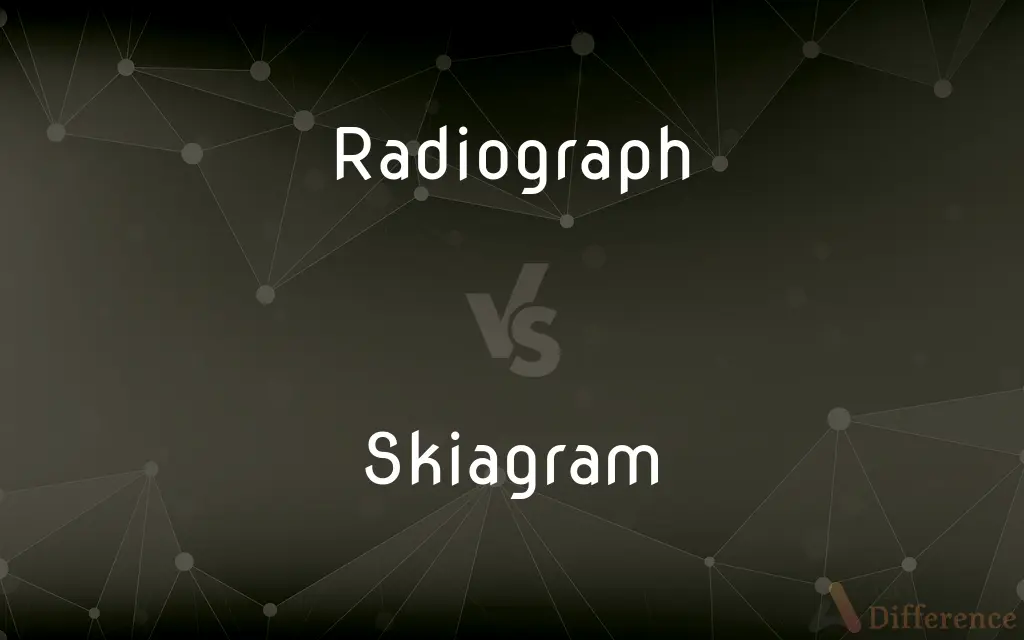Radiograph vs. Skiagram — What's the Difference?
By Maham Liaqat & Urooj Arif — Updated on April 23, 2024
A radiograph, commonly known as an X-ray image, captures internal body structures using radiation; a skiagram is an older term that refers to the same type of imaging.

Difference Between Radiograph and Skiagram
Table of Contents
ADVERTISEMENT
Key Differences
Radiograph is the modern term used to describe images produced by X-rays, which are utilized extensively in medical diagnostics to view bones, teeth, and internal organs. Skiagram, on the other hand, is an antiquated term that was once used interchangeably with radiograph but is rarely used in contemporary medical practice.
While both terms describe the same imaging process involving the use of X-rays to produce images of internal structures, the term radiograph is preferred in today's medical and scientific communities. Skiagram, although technically synonymous, might be encountered in historical contexts or older medical literature.
Radiographs are essential diagnostic tools in modern medicine, used to detect fractures, tumors, and other abnormalities within the body. Skiagrams, as they were once called, served the same purpose during the early days of X-ray technology.
The evolution from the term skiagram to radiograph reflects advances in medical technology and shifts in medical terminology. The transition underscores a move towards more standardized and globally recognized terms in the medical field.
Both radiograph and skiagram have played crucial roles in the development of diagnostic imaging, providing a non-invasive method to examine the body's internal conditions. However, the usage of 'radiograph' aligns with contemporary practices and terminology.
ADVERTISEMENT
Comparison Chart
Definition
An image produced using X-rays.
An older term for an image produced using X-rays.
Usage
Current, widely used in modern medicine.
Historical, rarely used in modern contexts.
Purpose
Diagnostics of bones, organs, and tissues.
Same as radiograph, diagnostics of internal structures.
Technological Context
Associated with modern medical technology.
Associated with early X-ray technology.
Terminology
Standard in contemporary medical practice.
Obsolete in contemporary medical terminology.
Compare with Definitions
Radiograph
An image produced by X-rays passing through a body, captured on a special film or digital sensor.
The doctor examined the radiograph for signs of the fracture.
Skiagram
Historical term for an X-ray image.
The early medical text discussed the use of skiagrams in diagnosing tuberculosis.
Radiograph
Digital versions are commonly used for faster processing and better image quality.
Digital radiographs can be instantly viewed and adjusted for clarity.
Skiagram
Produced by the same technique as radiographs.
The skiagram of his chest was taken in 1910.
Radiograph
Can show various densities within the body, such as bones and soft tissues.
The radiograph clearly showed the foreign object in the patient's stomach.
Skiagram
Was used to diagnose various conditions from fractures to diseases.
Skiagrams were essential in early 20th-century hospitals.
Radiograph
Used primarily in medical diagnostics to view internal structures.
Radiographs are crucial in diagnosing dental problems.
Skiagram
Now largely replaced by the term radiograph in medical terminology.
You might still find the term skiagram in very old medical journals.
Radiograph
Requires exposure to a small amount of ionizing radiation.
She wore a lead apron to protect from radiation during the radiograph.
Skiagram
Involved exposure to X-rays, like modern radiographs.
Early skiagrams often required longer exposure times to X-rays.
Radiograph
An image produced by radiation, usually by x-rays, and recorded on a radiosensitive surface, such as photographic film, or by photographing a fluoroscopic image. Also called radiogram, shadowgraph, skiagram, skiagraph.
Skiagram
A picture or photograph made up of shadows or outlines.
Radiograph
To make a radiograph of.
Skiagram
See radiograph.
Radiograph
An image, often a photographic negative, produced by radiation other than normal light; especially an X-ray photograph.
Skiagram
A picture or image created from shadows, especially with X-rays.
Radiograph
An instrument for measuring and recording solar radiation.
Skiagram
A photographic image produced on a radiosensitive surface by radiation other than visible light (especially by X-rays or gamma rays)
Radiograph
To produce a radiograph image.
Radiograph
An instrument for measuring and recording solar radiation.
Radiograph
An image or picture produced upon a sensitive surface, as of a photographic or fluorescent plate, by some form of penetrating radiation other than light, as X-rays, beta rays, etc.; esp., a picture of the internal structure of opaque objects traversed by the rays; a skiagraph. When the picture is produced upon photographic film by X-rays, the picture is usually called an X-ray photo or X-ray. When an image is produced on photographic film by a radioactive substance in close proximity to the film, in a manner so as to record the spatial distribution of the radioactive substance, the resulting image is called an autoradiograph or autoradiogram.
Radiograph
To make a radiograph of.
Radiograph
A photographic image produced on a radiosensitive surface by radiation other than visible light (especially by X-rays or gamma rays)
Common Curiosities
Is there any difference in the process of taking a radiograph and a skiagram?
No, the process of taking a radiograph and a skiagram is the same; the terms differ only in their historical usage.
What is a radiograph used for?
A radiograph is used to examine the internal structures of the body, such as bones, teeth, and organs, to diagnose various medical conditions.
Can a skiagram show soft tissue?
Yes, like radiographs, skiagrams could also show soft tissues, though with less contrast than bones.
What is the difference in technology between radiographs and skiagrams?
There is no technological difference; the difference lies only in the terminology. Both use X-ray technology to produce images.
Why is standardized medical terminology important?
Standardized medical terminology facilitates clear communication among healthcare providers worldwide, ensuring consistency and accuracy in diagnosis and treatment.
Are radiographs and skiagrams considered safe today?
Yes, with advancements in technology and safety standards, the use of radiographs is considered safe; exposure to radiation is kept to a minimum.
Why is the term skiagram no longer used?
The term skiagram has been largely replaced by radiograph as medical terminology has evolved to become more standardized and globally recognized.
Was there a specific reason why the term skiagram fell out of favor?
The term skiagram fell out of favor as the medical community moved towards more uniform terminology to better align with international standards and practices.
What are the risks associated with radiographs?
The risks associated with radiographs include exposure to a small amount of ionizing radiation, which is minimized with modern safety standards and technologies.
How are radiographs processed in modern medical facilities?
Modern radiographs are often processed digitally, allowing for quicker turnaround times and improved capabilities for analyzing the images.
What kind of conditions can be diagnosed with a radiograph?
Conditions such as bone fractures, lung infections, dental issues, and tumors can be diagnosed using radiographs.
Can both radiographs and skiagrams be used for the same medical procedures today?
While the procedures would be the same, only the term radiograph is commonly used in contemporary medical practice.
How has the use of radiographs evolved over time?
The use of radiographs has evolved with advancements in technology, including the shift from film to digital formats, which allow for immediate viewing and enhanced image manipulation.
How did early skiagrams differ in quality from today’s radiographs?
Early skiagrams generally had lower image quality and required longer exposure to X-rays, whereas today's radiographs benefit from enhanced imaging technology and safety features.
What advancements have been made in radiographic technology?
Advancements in radiographic technology include digital imaging, reduced radiation doses, enhanced image processing, and integration with medical information systems.
Share Your Discovery

Previous Comparison
Roaster vs. Roster
Next Comparison
Attic vs. BasementAuthor Spotlight
Written by
Maham LiaqatCo-written by
Urooj ArifUrooj is a skilled content writer at Ask Difference, known for her exceptional ability to simplify complex topics into engaging and informative content. With a passion for research and a flair for clear, concise writing, she consistently delivers articles that resonate with our diverse audience.













































